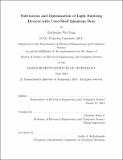| dc.contributor.advisor | Vladimir Bulović. | en_US |
| dc.contributor.author | Song, Katherine Wei | en_US |
| dc.contributor.other | Massachusetts Institute of Technology. Department of Electrical Engineering and Computer Science. | en_US |
| dc.date.accessioned | 2013-11-18T17:37:16Z | |
| dc.date.available | 2013-11-18T17:37:16Z | |
| dc.date.copyright | 2013 | en_US |
| dc.date.issued | 2013 | en_US |
| dc.identifier.uri | http://hdl.handle.net/1721.1/82185 | |
| dc.description | Thesis (S.M.)--Massachusetts Institute of Technology, Dept. of Electrical Engineering and Computer Science, 2013. | en_US |
| dc.description | This electronic version was submitted by the student author. The certified thesis is available in the Institute Archives and Special Collections. | en_US |
| dc.description | Cataloged from student-submitted PDF version of thesis. | en_US |
| dc.description | Includes bibliographical references (p. 79-84). | en_US |
| dc.description.abstract | Quantum dot light emitting devices (QD-LEDs) are promising options for the next generation of solid state lighting, color displays, and other optoelectronic applications. Overcoating quantum dots (QDs) -- semiconducting nanocrystals of CdSe, PbS, or another similar compound -- with a wide band-gap "shell" has recently been shown to significantly boost QD-LED performance and yield the most efficient accent QD-LEDs to date. This thesis studies fabrication techniques to make bright, efficient QD-LEDs with these "core-shell" QDs. The first part studies the electrophoretic deposition (EPD) of CdSe/ZnS QDs. QD-LEDs conventionally utilize a QD lm that is deposited via spin-casting, a reliable but highly unscalable technique for the deposition of thin, smooth films of QDs for QD-LED applications. Potential advantages of EPD include the ability for deposition onto a variety of substrate shapes and more energetically favorable QD packing. Devices made with EPD QD films exhibit peak efficiencies comparable to those of devices with a spun-cast QD layer and turn-on voltages surprisingly lower than the optical band-gap of the QDs. These results suggest that EPD is a viable alternative to spin-casting for the processing of QD-LEDs. The second part of this thesis explores the role of core-shell QDs in creating bright, efficient LEDs in the near-infrared ([lambda] >1 [mu]m) regime. Infrared QD-LEDs with record brightness and efficiencies are obtained by using QDs in which lead sulfide (PbS) cores are overcoated with a cadmium sulfide (CdS) shell. In situ photoluminescence quantum yield measurements confirm that the QD shell plays a significant role in shielding the emissive QD core from external quenching mechanisms. Finally, fabrication and material considerations for the non-QD layers in the modern QD-LED structure are also discussed. This thesis analyzes different film formation techniques for zinc oxide (ZnO), the electron transport layer in the QD-LEDs, and different materials and thicknesses for the organic hole transport layer. | en_US |
| dc.description.statementofresponsibility | by Katherine Wei Song. | en_US |
| dc.format.extent | 84 p. | en_US |
| dc.language.iso | eng | en_US |
| dc.publisher | Massachusetts Institute of Technology | en_US |
| dc.rights | M.I.T. theses are protected by
copyright. They may be viewed from this source for any purpose, but
reproduction or distribution in any format is prohibited without written
permission. See provided URL for inquiries about permission. | en_US |
| dc.rights.uri | http://dspace.mit.edu/handle/1721.1/7582 | en_US |
| dc.subject | Electrical Engineering and Computer Science. | en_US |
| dc.title | Fabrication and optimization of light emitting devices with core-shell quantum dots | en_US |
| dc.title.alternative | Fabrication and optimization of LEDs with core-shell quantum dots | en_US |
| dc.type | Thesis | en_US |
| dc.description.degree | S.M. | en_US |
| dc.contributor.department | Massachusetts Institute of Technology. Department of Electrical Engineering and Computer Science | |
| dc.identifier.oclc | 862075607 | en_US |
